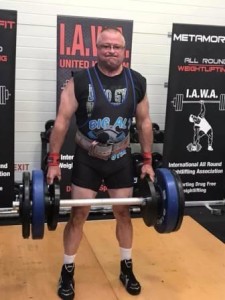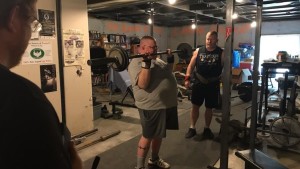New Lift – The Rim Lift
By Al Myers

I performed the Rim Lift at the 2018 IAWA Gold Cup in Eastbourne England. I feel it will be a great new lift for the USAWA!
At the National Meeting the USAWA membership voted to accept a new lift put forth by the executive board for approval. The Rim Lift was presented to the EB for new lift status back in 2020 before the COVID pandemic by LaVerne Myers. LaVerne had “tested out” the Rim Lift at the 2020 Grip Championships he promoted as an exhibition lift. Several lifters took part after the meet in trying out the Rim Lift, in which all seemed to really enjoy it. A few lifters went over 300 pounds in this trial – Jason Payne did 340, and Dave Glasgow, Eric Todd, and Chad Ullom did 300 pounds. LaVerne, at 75 years of age, did 280.
The Rim Lift is an official lift in the IAWA-UK, and has been for a long time. The USAWA rule for it is the same as the IAWA-UK rule, which is as follows:
Rim Lift
The lift may be performed under the official rules of the Deadlift, Hacklift, or Jefferson Lift while only holding onto the rims of the gripping plates with the thumbs on the inside and the fingers over the rims of the plates. The maximum plate diameter is 18 inches. If smaller plates are used for the gripping plates larger (18″ max diameter) plates may be added to the outside. The gripping plates must be flat and smooth on the inside surface, and the rim cannot be deeper than 1 inch. It is an infraction to grab any handles, holes, or specially prepared areas on the plates to aid in gripping. Any length of bar may be used as the distance between collars is optional. The lifter must finish the lift in an upright position and under control. Once motionless, the head official will give a command to lower the bar.
At the meeting I made an amendment to the lift proposal to accept the prior lifts done at the Grip Champs to count retroactively and be the first Rim Lift records in the record book. The Rim Lift will be added to the updated USAWA Rule Book.

